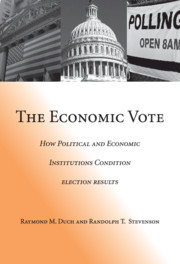Book contents
- Frontmatter
- Contents
- Preface
- 1 Introduction
- Part I Describing the Economic Vote in Western Democracies
- Part II A Contextual Theory of Rational Retrospective Economic Voting: Competency Signals
- Part III A Contextual Theory of Rational Retrospective Economic Voting: Strategic Voting
- 8 Responsibility, Contention, and the Economic Vote
- 9 The Distribution of Responsibility and the Economic Vote
- 10 The Pattern of Contention and the Economic Vote
- Part IV Conclusion and Summary
- Appendix A
- Appendix B
- Appendix C
- References
- Index
- Cambridge Cultural Social Studies
10 - The Pattern of Contention and the Economic Vote
Published online by Cambridge University Press: 06 July 2010
- Frontmatter
- Contents
- Preface
- 1 Introduction
- Part I Describing the Economic Vote in Western Democracies
- Part II A Contextual Theory of Rational Retrospective Economic Voting: Competency Signals
- Part III A Contextual Theory of Rational Retrospective Economic Voting: Strategic Voting
- 8 Responsibility, Contention, and the Economic Vote
- 9 The Distribution of Responsibility and the Economic Vote
- 10 The Pattern of Contention and the Economic Vote
- Part IV Conclusion and Summary
- Appendix A
- Appendix B
- Appendix C
- References
- Index
- Cambridge Cultural Social Studies
Summary
The previous chapter established that voters condition their economic vote on the current distribution of policy-making responsibility among parties competing for election. In this chapter, we examine whether the data also support our theoretical proposition that voters condition their economic vote on the extent to which parties are “in contention” for policy-making responsibility in the future. Our theory assumes that voters know the extent to which different parties and coalitions of parties contend for significant shares of policy-making responsibility. We support this assumption with survey evidence from three countries that shows that voters are surprisingly well informed about the pattern of cabinet contention, even in very complex coalitional systems. With this assurance that, in the few cases for which we have direct evidence, our information assumptions are plausible, we next propose two different methods for measuring beliefs about cabinet contention in the larger number of cases in our sample (for which direct survey data about beliefs are not available). Finally, in the rest of the chapter, we use these measures to test three general hypotheses (all implied by the theory in Chapter 8) about how the pattern of contention for policy-making responsibility conditions economic voting.
VOTER BELIEFS ABOUT THE PATTERN OF CONTENTION
Our model of economic voting assumes that voters have knowledge about which parties or coalitions of parties are likely to form the government or otherwise participate in policy making.
- Type
- Chapter
- Information
- The Economic VoteHow Political and Economic Institutions Condition Election Results, pp. 287 - 334Publisher: Cambridge University PressPrint publication year: 2008

